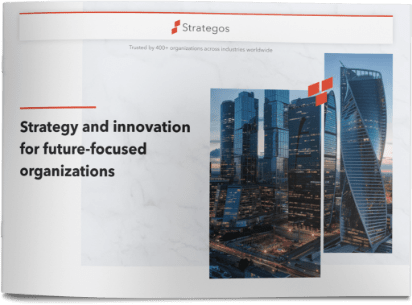When times are good, people underinvest in strategic innovation initiatives because there is no sense of urgency. When times are bad, they underinvest because of a lack of resources and more pressing priorities. Strategos performed a study among 500 senior and mid-level managers in large U.S. companies, asking them to identify the biggest barriers to funding innovation. The top response was short-term focus, followed by competition for resources.
The vast majority of CEOs believe innovation is key to the success of their companies, and the current economic climate is such that a lack of resources isn’t usually the issue. So why does starting strategic innovation initiatives seem so tough in boom times, and how can CEOs break the impasse?
Why starting strategic innovation initiatives can be hard
Study a company that has delivered strong revenue growth over a decade or more, and you’re likely to find evidence of world-class innovation. Look further and this world-class innovation is the result of ongoing investment, focus, and support from the top in both up- and down-cycles—the same as we would do to achieve excellence in any other area.
Paradoxically, golden ages of business growth can be lethal to starting strategic innovation initiatives, because while in concept resources should be available, in reality businesses can find themselves scrambling to meet rising customer demand while fighting off both successful incumbent competitors and well-resourced new entrants. At the same time, the pressure to grow the top line while reducing costs never goes away; as a result, innovation can easily get squeezed into the “nice to have” category.
When the solution becomes the problem
Every organization innovates, but approaches vary, and so do the results. In some cases, we see CEOs communicate the importance of innovation publicly, and expect that to be enough to motivate employees to act differently and start to innovate by themselves. This usually leads to well-intended but ad hoc initiatives. Imagine a business unit of a tech company organizing a hackathon to find new ideas that help them deliver new solutions, while the HR department organizes training on creative skills. Both are potentially worthwhile efforts, but it is unclear how they link together and strengthen the organization’s overall innovation capability.
In other cases, we see companies acting on the hope that implementing single tools like customer experience mapping will somehow make them innovative. While these point solutions can be useful as part of a larger tapestry, in isolation they almost never generate real results, and the enthusiasm for innovation wanes quickly.
The world’s top performers approach innovation in a more strategic way. CEOs paint a bigger picture of how they expect innovation to contribute to the overall business, where they want to focus their innovation efforts, and what organizational changes they will start to implement to make it all work. In this case, strategy and innovation are closely linked and it is clear how innovation supports a more ambitious, longer-term goal.
To win at innovation, there are several important choices to be made and questions to address.
Get the rest of the executive team on board for strategic innovation
As the CEO, innovation may be part of your plan, but that doesn’t automatically mean the rest of your team is on board. CEOs who talk about the importance of innovation still need to create buy-in and alignment with their executive team.
The questions to address: What’s in it for them? How will innovation efforts contribute to the performance of their parts of the overall business, and what is the scope of innovation that collectively we will have to focus on to make that happen? Ultimately, this executive dialogue creates a shared vision of success with innovation at the core.
Explicitly split resources between core business growth AND new areas for growth and renewal
When investments in ideas for future growth compete head-to-head with opportunities that grow the business of today, the future usually receives the short end of the stick. When we worked with a client in the steel industry, they simply couldn’t get promising ideas to make it past the paper stage. The cause was simple: Unit leaders tended to favor decisions that “sweated the assets” over ones that might (or might not) fill their future pipelines.
As part of executive alignment, we need to make decisions about where to play and how to win, but equally how that translates into investments in core vs. adjacent vs. new areas.
Create an Innovation System
It is highly unlikely that all the required innovation capabilities to deliver your growth vision exist in your company today. Innovation leaders develop policy- and process-based organizational capacity, not just individual capabilities, to ensure lasting innovation success.
And it’s not just about generating ideas. Identifying broad opportunity platforms, articulating winning business models, and executing commercialization through agile approaches are all prerequisites before the cash register begins to ring. Infrastructure to nurture ideas that do not immediately fit the core business, such as a corporate incubator or accelerator, may be part of what’s needed. And leadership needs to be able to navigate different innovation infrastructure options, understand which one is right in each situation, and execute a portfolio of coordinated approaches.
Leaving a legacy
Whirlpool CEO Dave Whitwam began the company’s transformation in 1999 from a manufacturing-driven organization to a consumer-driven one with innovation at the core. He didn’t see innovation as a project or a one-time event, but invested in developing enterprise-wide capabilities and an innovation core competence that created tangible success. That outlasted his tenure as CEO and produced substantial shareholder value that has lasted for over a decade.
In down times, only the strongest and most visionary CEOs can resist the pressure of quarterly results and present a vision for the future that is backed up with clear and focused innovation plans that link to strategy.
And in boom times, it requires real leadership to set the stage for future prosperity in both good times and bad. By aligning your team, managing a diverse opportunity portfolio, and taking a systemic view of organizational capability, you have a much better chance of leaving your own legacy.
Read the Whirlpool case study published on Harvard Business Review





